

The rapid and painful consequences arising from the incorporation of Greek economy in a regime of European and international supervision aimed at preventing the bankruptcy of the Greek financial structure has already been made visible. Processes that appeared at the start of 2009 are now gradually exacerbating: subversion of employment relations due to the introduction of flexible working arrangements, increasing unemployment, deterioration of living conditions, bankruptcy of many enterprises, repayment default of personal and business loans, and dislocation of the welfare state. As a result, a large group of young people are now seeking new opportunities for work and professional development in international markets, beyond the dead-ends of a Greek reality, while increasing criminality and a growing environment of social rage and violence has accomplished an overall picture of social agitation.
However, that critical condition we are living in, which jeopardizes all our certainties, has not only negative and discouraging effects. Apart from the “deflation” of the presumed economic prosperity we had experienced over the last decades, what is happening now in Greek society has to do with an intense cultural dislocation: the mentalities of complacency and the logics of clientelism which formed the basis of our political system. The exploitation of every aspect of public domain (wealth, space, political arenas) formed practices that stigmatized the pathogenic character of corruption. These practices led inevitably to stagnation and to the need for the re-evaluation of priorities, certainties and practices though which we have been living our lives up to now. In an attempt to modernize old and ineffective structures that until recently seemed unshakable, radical reformations of the Greek administrative and economical system are being urgently realized. And, while the Greek prime minister, George Papandreou, calls on citizens to make the “revolution of the self-evident”, deep-rooted beliefs, bottlenecks and inactions increase the general sense that restoration and development are not yet to come, while the consequences of the economic crisis place a disproportionate burden on already weak social groups: immigrants, women, elderly persons, and new entrants in labor market.
It may sounds banal, but it seems that the dislocation of every certainty that we experience these last years have pushed us to re-think our relations with people and things, to reinvent the lost meaning of notions like “solidarity”, “social responsibility”, and “humanism”, as well as to re-evaluate our attitudes towards material culture and consumption.
Additionally, institutions, large-scale projects, and other smaller-scale initiatives have brought back to the foreground the forgotten political dimension of art, supporting, or undertaking unconventional actions in public spaces, beyond the safety of museum walls. When I refer to the “political dimension of art”, I don’t necessarily want to point out clichéd attempts to denounce the political system or institutions or to stress efforts to represent realistically the condition of a painful everyday life. On the contrary, I am referring to the critical space created by art that allows an original understanding and interpretation of the politics and human relations. In that sense, art is inscribed in the realm of politics, whether it is clearly oriented towards the investigation of critical social issues or not.
Praxis: Art in Times of Uncertainty
The investigation of the influence of social change in artistic creation and the detection of critical research shifts towards issues of collective interest oriented the curatorial direction of Thessaloniki Biennale. In 2009, the 2nd Thessaloniki Biennale of Contemporary Art, organized by the Greek State Museum of Contemporary Art, attempted to record the state of art in “times of uncertainty” focused on a dialogue between artists from prominent geopolitical centers and their colleagues from distant and not easily accessible areas – an aim well inscribed within the broader agenda of Thessaloniki Biennale of Contemporary Art. The 2nd Thessaloniki Biennale, curated by Gabriela Salgado, Bisi Silva and myself, attempted to bring together in one exhibition the work of artists from Latin America, Africa, West Europe and the Balkans. Based on the work of the English theorist, Terry Eagleton, After Theory, the exhibition Praxis: Art in Times of Uncertainty tried to trace the emerging sense of awakening that seems to follow the lethargy of uncritical and total disregard of ideologies and sociopolitical systems. Wondering whether the time for the re-examination of the inherent value of artistic practice has come, whether “the moment to explore art as a privileged space for relatively free expression of ideas and for an alternative view of the world” has arrived, the exhibition presented groups and single artists whose art returned back to life, back to praxis and to collective creation contributing to the formation of a political view and proposing new ways of co-existing with the “other”.
The Thessaloniki Biennale guarantees the internationalized character of the visual arts in Thessaloniki. Among the 150 artists and groups that were chosen for their quality of transforming contemporary sociopolitical questions into visual art, were Chto Delat? (What is to be done?), a contemporary Russian collective of intellectuals and visual artists. Named by Lenin’s homonym manifest published in 1902, which claimed the need for the formation of a revolutionary party, their film, Perestroika Songspiel. The Victory over the Coup, a heretical hybrid between ancient tragedy and musical, recomposed lyrically the recent history of Russia after the collapse of the Soviet Union. Identifying the heroes of the new era: the idealist democrat, the gentle businessman, the revolutionary, the nationalist, and the woman who found her lost voice, the chorus in the lyric interludes deconstructed the illusions of the protagonists for justice within the capitalist system in an ironic manner.

Chto Delat, Perestroika Songspiel. The Victory over the Coup, 2009. Video still
In her video projection Mumbai: A Laundry Field, Kimsooja takes us through the slums of Mumbai, contrasting the seductive colorful laundry to the tragic poverty of the abandoned social strata, the bad plumbing system, and the suffocative accumulation of people in the settlements.
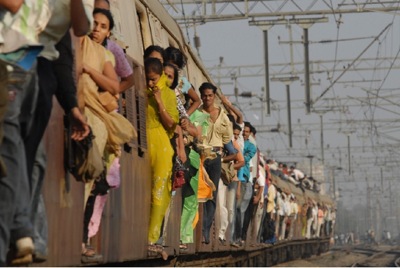
Kimsooja, Mumbai: A Laundry Field, 2007-8. Video still
In All that is Solid Melts into Air, Mark Boulos suggests an alternative reading of the Marxist notion of “commodity fetishism” focused on the “metaphysical” qualities of petroleum. One screen projects scenes from the activities of the Movement for the Emancipation of the Niger Delta against the international corporations that steal the petroleum from the natives with the collaboration of Nigerian state, while another screen shows scenes from the Chicago Mercantile Exchange during the period of the recent financial crisis.


[left] Mark Boulos, All that is Solid Melts into Air, 2008. Chicago Mercantile Exchange. Video still
[right] Mark Boulos, All that is Solid Melts into Air, 2008. MEND fighter, Niger Delta. Video still
Gulnara Kasmalieva and Muratbek Djumaliev, in their video work A New Silk Road: Algorithm of Survival and Hope, attempt to recompose the contemporary economic reality focused on Kyrgyzstan’s role in the conduct of international trade and the dramatic changes effected in the lifestyle of the people of Central Asia after the collapse of Soviet Union.
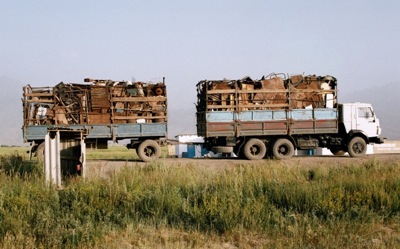
Gulnara Kasmalieva, Muratbek Djumaliev, A New Silk Road: Algorithm of Survival and Hope, 2007. 5 channel video installation, photographs
Jodi Bieber, in her photographs from ‘Las Canas’ series, portrays stories of degradation from the everyday life of drug users in Spain.
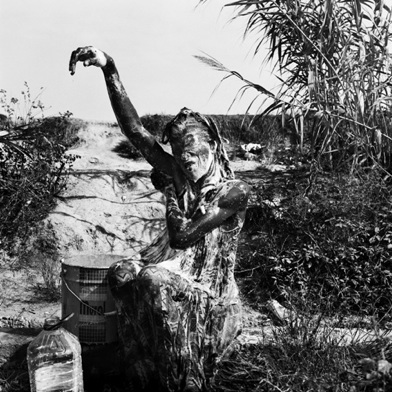
Jodi Bieber, Las Canas, 2003. Photographs
While the complexity of the experience between individuals, groups, nations, social categories, genders and religions has been interwoven with globalization and more recently, the economic crisis in Greece, encounters of personal narrations with collective experiences, traumas, expectations, and losses, as well as the profound political and economical changes that jeopardize social cohesion, has formed the canvas on which the narrative of contemporary art is unwrapped. This narrative is structured around the axis of the urban experiences of a medium-sized Greek urban center, namely Thessaloniki: a city with complex social tissue and a multi-national character enriched by the latest immigration of people from the regions of the former Soviet Union, rich historical heritage, and cultural stratification. Ottoman monuments, covered markets, museums of Byzantine and Modern art, open places, stores and warehouses in the port – all these composed the topography of the exhibition spaces of the Biennale in an attempt to incorporate organically contemporary art into the urban fabric through the selection of different institutional and alternative spaces.
Personal-Political
The exhibition Personal-Political, part of the parallel program of the 2nd Thessaloniki Biennale, was in part conceived in accordance with the revival of political discourse generated by the explosion of violence provoked by the murder of the student Alexis Grigoropoulos by a police officer in Exarchia, a central neighborhood of Athens, in December 2008. The exhibition’s curators, Theodoros Markoglou and Areti Leopoulou, attempted to investigate the integral relation of art to politics in Greek art, intended to heed “the Greek artistic reality, as it is being shaped following a series of political and social changes and events, which affect every facet of people’s personality and daily life” on the basis of the theoretical assumptions of Jacques Rancière, the Situationist International, and Terry Eagleton.
Harris Kondosphyris participated in the exhibition Personal-Political with a series of ink drawings. His drawings, based on photos published in newspapers, depicted realistically recent conflictual events discussed in mass media.

Harris Kodosphyris, Criminalisation, December 2008. Drawing with a ballpoint pen on paper
Alexandros Avranas’ work is focused on the issues of violence and suppression. He participated in Political-Personal with his work Basij, a name referring to Iran’s volunteers’ militia. In Basij, the artist discusses the uniform of the forces of order as symbol of power depicting a modern threatening frieze containing distinctive marks of the forces of order regardless of their source. In Klitsa Antoniou’s installation Demining, the female archetype is de-mining the field of a supposed safe domestic space investigating the intimate relation between the displaced individual and her personal environment. Natasha Poulantza overturns the stereotypical “heroic” image of the leader of the October Revolution; building on the traditional structure of a sacred iconostasis, the artist embodies in Lenin’s portrait kitsch elements of worship, she depicts him disguised into a farmer treating his figure as pop idol.
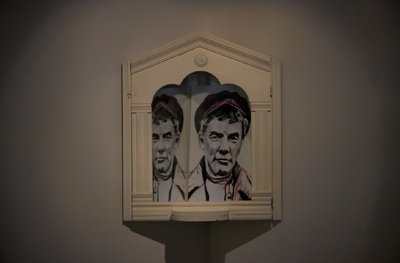
Natasha Poulantza, Portrait 1917, 2008. Acrylic on canvas, mirrors, led lights
In Roumelis’ Mountain, Kostas Tsolis explores a very risky topic, the grey zone of the Greek collective memory, recalling scenes of bloodshed and violence in the Greek civil war. The brilliant video-animation of Theofanis Nouskas’ Molotov Industry comments on the commercialization of modern forms of protest and their submission in the industrial system of mass production.
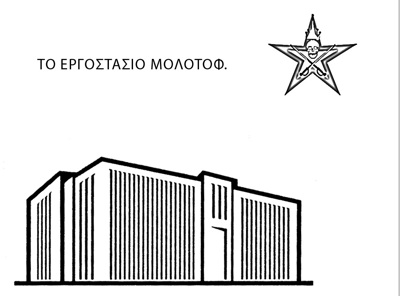
Theofanis Nouskas, Molotov Industry, 2009. Video – animation
In Votive (1969), Leda Papaconstantinou proceeds in the ritual marking of the female naked body with the symbol of cross confirming the critical conjunction between religiosity and sexuality in the body as a field of claim and pleasure. This concept, underlying the entire work of the pioneer Greek performer, acquires a new powerful meaning in the current ‘critical times’. Since the late 60’s, Leda Papaconstantinou focuses mainly on the practice of bodily involvement in the artistic action through the art of performance. Her work aims at the critical examination of the fundamental definitions of gender identity.
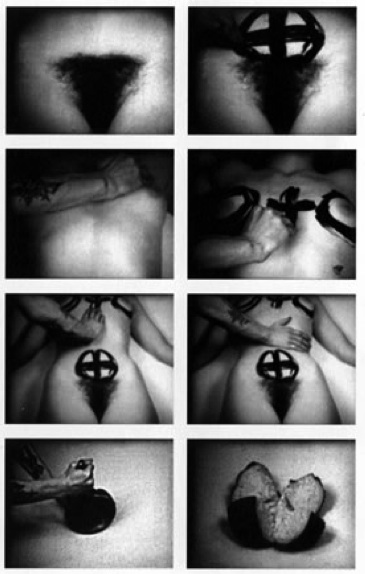
Leda Papaconstantinou, Votive, 1969. Video still
The exhibition Personal-Political revealed the existence of an important number of Greek young artists with studies in Greece and abroad, artists with intense mobility and ability to meet the demands of European and international developments in contemporary art. Additionally, the exhibition, in a historical perspective, tried to associate the work of young artists with similar investigations of older generations of artists, who articulated their subversive visual discourse already in the 60’s and 70’s. Seeking for the condition within which individual experience is articulated in the context of community, the exhibition’s curators tried to answer questions such as the relations between individual and power, globalization and its mechanisms, the system of communication between art and its audience, the promotion and distribution of art, the religious attachment to different types of idols, family structure and experience, through a complex inter-generational presentation of Greek art.
Politics of Art
The international exhibition Politics of Art, curated by Anna Kafetsi, was inaugurated on October 2010 at the National Museum of Contemporary Art in Athens, Greece, including works of forty artists from the collection of the museum. As far as it was formed almost exclusively by acquisitions that became the basis of the collection during its ten years of its operation, the exhibition illustrated the persuasions and the politics of collection of the museum. The museum collection was not treated as a static entity but as a dynamically growing field of dialogue, which was forming and re-forming constantly in conjunction with the global socio-political environment and the priorities set by the museum’s director— aimed at investigating “ways and strategies of the presented works, which directly or allusively refer to political, financial and social issues and events, the political potential of contemporary art, inventing itself as another way of talking about what the politicians and scholars are speaking about, and its possibility to function as a pivot of critical and alternative political thinking and action. Alternative policies for collective action and artistic activism and a new interactive relationship between the artist and the community, both local and global”* were at the center of a critical reflection highlighting invisible or less visible aspects of the social role of artistic creation.
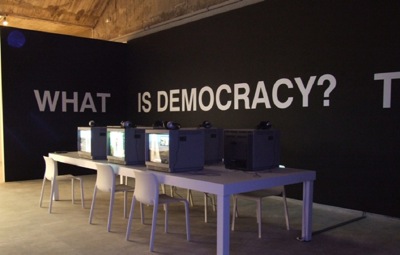
Oliver Ressler. What is Democracy?, 2007 – 2009. Eight channel video installation.
In the exhibition, different kind of works coexisted in a fruitful dialogue, including Oliver Ressler’s eight channel video installation What is Democracy? (2007 -9), presenting testimonies of scientists and activists on the meaning, the content and the crisis of democratic regime, and George Osodi’s photographic installation On Rich Niger Delta, (2003 – 2007) showing images from the everyday life in Niger Delta. As in the case of Mark Boulos’ video-installation, Osodi’s visual interest is focused on the financial exploitation of Nigeria by petroleum companies. However, in Osodi’s work the comparison is not between African and Western economies, but between the enchanting landscape of the African inland and the environmental degradation of the land and its inhabitants.
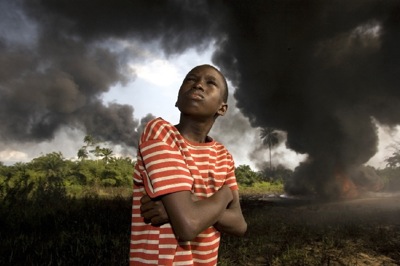
George Osodi, Oil Rich Niger Delta, 2003- 2007. Photographic Installation
The questions of re-claiming public space and expressing freely feelings and opinions through political graffiti that publicly denounce social injustice define the ideological basis of Carlos Motta’s “Graffiti Cuts: Who Owns the Street” (2007-2009). Eirene Efstathiou’s “Anniversary” (2010) re-composes representations of the Athens Polytechnic Uprising in 1973 in 36 paper lithograph prints based on photos published in newspapers and documented events that took place during the celebrations/demonstrations of the anniversaries in the period 1974-2009. Another work of the same artist is “Agony is Our Triumph” (2010), a series of five paintings based on photographs from the personal image archive of the artist depicting events of disorder that took place in Athens in December 2008.
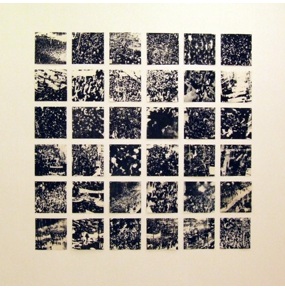
Eirene Efstathiou, Anniversary, 2010. 36 paper lithograph prints
The exhibition Politics of Art functioned as a platform of dialogue between artistic works from the 70’s, like Dimitris Alithinos’ Event (1973), Vlassis Caniaris’ Hopscotch (1974), and Theodoros Papadimitriou’s Manipulations – Antispectacular (1974) and works of the last decade made by artists working in Greece and abroad. The osmosis of the visual representation of the agonies and expectations of older and younger artistic generations contributes to the increase of the political sharpness of artistic proposals, which continue to give meaning to our era with the power of their images and meanings. In that context, Danae Stratou’s Cut – 7 dividing lines (2007) locate the experience of marginalization, of artificial segregation, and of the deported individual into a globalised environment, updating Vlassis Kaniari’s approach in Immigrants (1971-6).
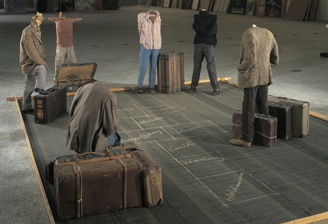
Vlassis Caniaris, Hopscotch, 1974. Environment
The exhibitions Politics of Art, and Personal-Political, as the entire 2nd Thessaloniki Biennale of Contemporary Art raised the question of the role of art in a critical era of high-stakes both at a local and translocal level. Important developments, such as the turnover of the artificial political balances in the European Union, the big social shocks hit the countries of the South Europe due to economic crisis, and the recent ongoing political and social inflammation in the Arabic world have rendered art into a fast-evolving, sensitive to global anxieties, and active area of policy consultation. All these developments inevitably reinforce each other and influence everyday life and human relations.
Some of its characteristics, like narrativity, the utilization of technologies, and the topics it deals with, bring together contemporary art to cinema. A good example is the issue of power relations within family life. In Childhood Abused, presented in the exhibition Personal-Political in the 2nd Thessaloniki Biennale, Christina Calbari deals with the broader issue of the political dimension of family relationships focused on the formation of inequalities in the exercise of power.

Christina Calbari, Childhood Abused, 2005
Furthermore, some Greek films, namely Panos Koutras’ A Woman’s Way: Strella, and Giorgos Lanthimos’ Dogtooth that received credits and awards in many international film festivals, deal with the traumas, the compulsive ringer and the collapse of the existing form of family while at the same time permit the fantasy of alternative family relationships and intersubjective links. Dogtooth is an allegoric anatomy of an authoritarian family, which can be also understood as an allegory of totalitarian social structures. Without reproducing the existing and well recognized family model, the film illustrates the psyche and the reactions of young people raised in an artificially enclosed and isolated environment, where parents attempt to control totally their views about the entire world, starting from the level of linguistic communication and of the signification of words.
Dogtooth Official Trailer
A Woman’s Way: Strella, based on the tradition of melodrama and the structure of ancient tragedy, focuses on the love affair of a young transsexual prostitute with a middle-aged ex-prisoner, who turns to be her father. Giving the hope that reconciliation and mutual acceptance in a new kind of family are possible, the movie finishes with a scene of a different king of family warmth: the protagonist celebrates Christmas with her friends and her father in their home; the two of them have accepted the new reality after their love affair and the tragic revelation of their blood relationship. The end of the film portrays a relieved exit, an optimistic re-start of family bonds, an utopic but not impossible cohabitation.
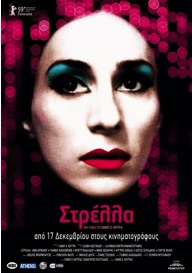
Poster of the film A Woman’s Way: Strella. Starring: Mina Orfanou
This brief overview of the fruitful crossover between art and sociopolitical crisis ends as it begins: with a modern hybrid melodrama which is resting on ancient tragedy: Panos Koutras’ A Woman’s Way: Strella and Chto Delat?’s Perestroika Songspiel. The Victory over the Coup share the freedom of the artist to envision an heretical way of living, transcending personal and collectives traumas. Art has the power to surpass geopolitical divisions transforming global community into a collective narrative web made by different personal stories that complete or overturn official narrations. In an era of painful changes, uncertainties and reconstitution of the once self-evident identities of the subjects, the role of art is more fundamental and critical than ever, as it creates new points of view, and proposes new interpretations of the existing world and social relations.
*Excerpt from the introduction of Anna Kafetsi, Politics of Art, Exhibition Catalogue, National Museum of Contemporary Art, Athens 2010, p. 6-7



